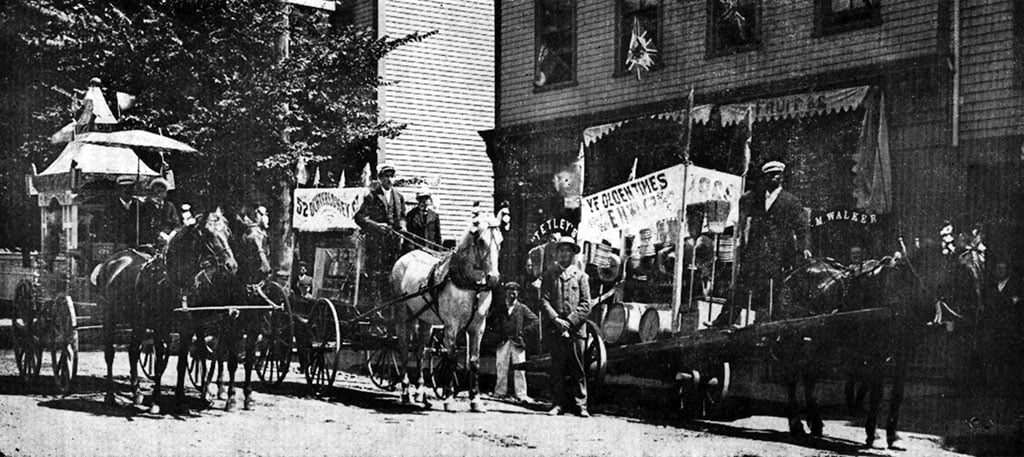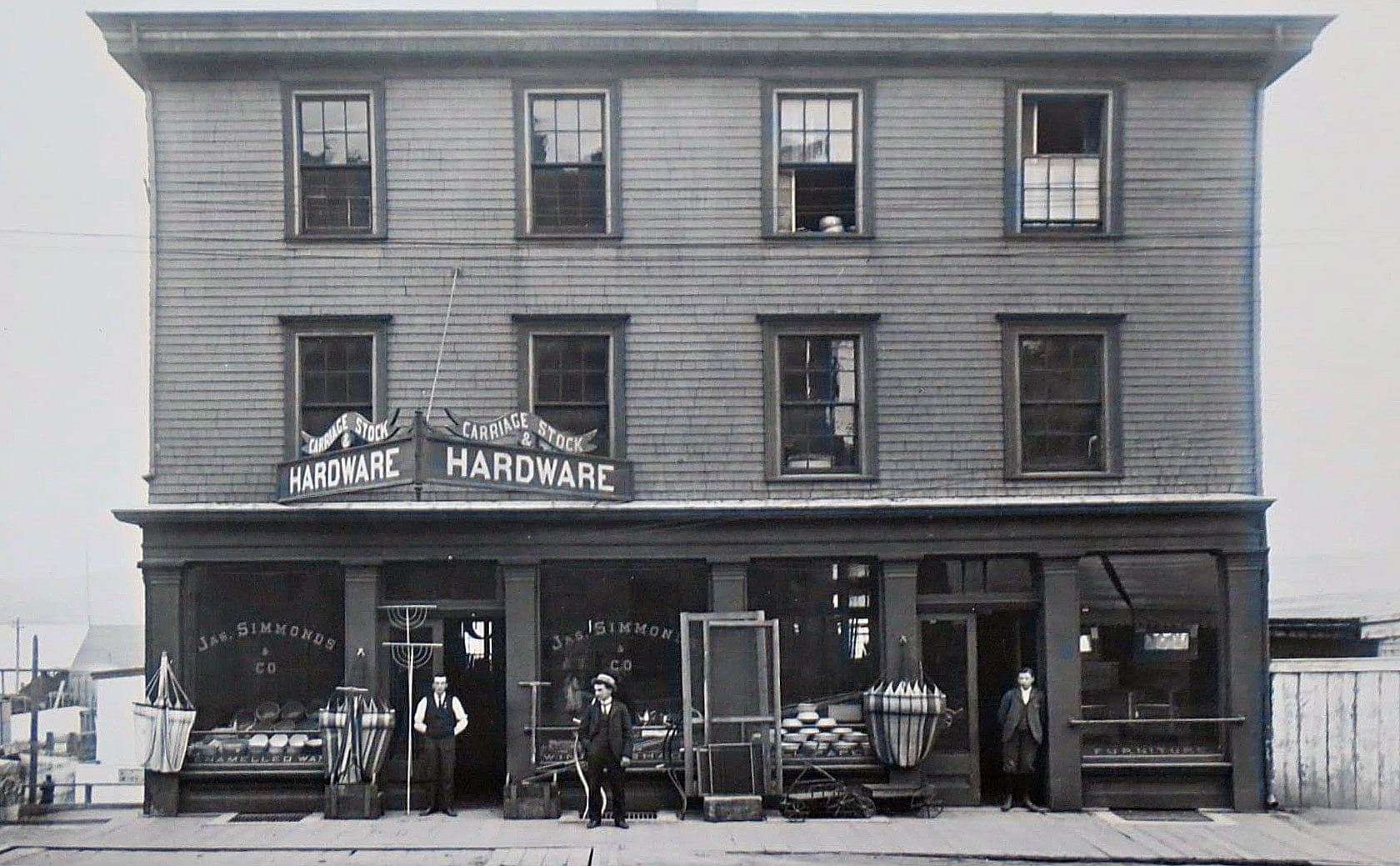From The Story of Dartmouth, by John P. Martin:
In 1920 we had the coldest winter for years. There were 21 days of good sleighing, and 11 days of sub-zero weather in January with the mercury down to 17 below near the month-end. In February the harbor froze over for the first time since 1898. The ferries kept a lane open, and the tug “Ragus” bucked her way daily from the Sugar Refinery to the Imperial Oil wharf at Halifax. On a Sunday afternoon, a number of us skated from Mill Cove to McNab’s Island, without experiencing any difficulty except in hopping over the ice-pans in the channel of the “Ragus” off Woodside.
Robert Lynch, who had been eight years in the Town Council, opposed Dr. Simpson in the Mayoralty election and got 525 votes to the Doctor’s 617. A motor-driven ladder truck was purchased and the first Town Engineer appointed in the person of H. E. R. Barnes. The Dartmouth Housing Commission was organized with J. J. O’Toole as Chairman. Other members were James A. Redmond, Albion B. Smith, George Mitchell and Ralph W. Elliot.
The Dartmouth Amateur Athletic Association was organized in March with a membership of nearly 400, and secured a 21-year lease of the Chebucto Grounds. Leo Graham was the first President. About that time an 8-page newspaper called “The Independent” was started by Arthur Johnston, son of A. C. Johnston. The Halifax Institute of Engineers now reported that an overhead bridge across the harbor was impracticable, and suggested a low-level drawbridge to accommodate rail and other traffic. The cost was $2,000,000. “The Independent” thought this decision a fortunate one, stating that if people had to wait for a $10,000,000 overhead bridge, “they would be still waiting when the new millennium dawned”. The Ferry Commission in February passed a resolution recording, “its hearty appreciation of the efforts of the Halifax-Dartmouth Bridge Committee, with the hope that their efforts would be crowned with success”.
Ex-Councillor John Ritchie died that spring, as also did James W. Tufts a member of the Dartmouth Park Commission continuously since 1891. Another prominent citizen to pass away was ex-Mayor Edward F. Williams. He had served as Chief Magistrate for a total of eight years, having previously sat six terms as a Councillor.
We got our first piece of permanent road on this side of the harbor in 1920 when Cavicchi and Pagano paved the stretch from the town limits to Horton’s Brook at Imperoyal. It was one of the first sections of permanent-surfacing completed by the Highway Department in the whole Province, and was commenced a few months before the local election. Considerable credit for this undertaking should go to Hon. Robert Finn, a former Dartmouthian, who was always alert to the interests of his constituents in eastern Halifax County
The work of rehabilitating explosion-damaged houses was just about finished up that summer. The stone Downey house on Coleman Street, built by Joseph Moore in early Canal days, was so badly shaken that it had to be demolished. More new residences went up in the north-end, also in Austenville, in Hawthorne-Sinclair Street sections, on Elliot Street, on upper Portland Street, in the Charles Harvey subdivision at Prince Arthur’s Park and on Rodney Road.
Falconer’s field was subdivided by Engineer J. Lorne Allan, and streets there were named for ex-Mayor Williams and Dr. M. S. Dickson. Sewerage and water pipes were extended to new houses on Elmwood Avenue, which had just been cut through the former Torrens field. At Manor Hill, where Andrew Shiels once wrote poetry the Eastmount subdivision of S. A. Heisler was selling lots as low a $100. Streets were named for military leaders in World War I.
The yearly report of the Housing Commission showed that 21 dwellings in Dartmouth were erected with their loans, on as many vacant lots. The Canadian Bank of Commerce opened a branch at the northeast corner of Portland and King Streets. Laurie Bell was now operating a small garage on the location of the present Police Station. The new Grace Methodist Church was completed and dedicated on Sunday, November 14th. South of the Church on King Street, Dartmouth’s second fire-engine house was torn down. This was an ordinary-sized shed in which were stored the watering cart and the antique fire-engine, pumped by hand. A valuable tourist attraction was lost when this relic was later sold for junk.
The school enrolment that year was 1,628. Grover C. Beazley joined the teaching staff to assist Principal Stapleton and Miss Findlay at Park High School where a class in Grade 10 was established in 1920. The Manual Training branch was abolished, and the work room converted into a shooting gallery for the cadet corps.
Ferry receipts fell and expenditures increased during 1920, for the second year in succession the Commission suffered a deficit. That year they went behind nearly $18,000.
The first electric street lights of Dartmouth were strung diagonally so that the light was suspended in the middle of intersections. In a wind-storm, the saucer-shaped disc rocked, swayed and almost turned turtle.
Central School served the Town for half a century until rendered uninhabitable by the 1917 Explosion, although the roof still remained tight. After that, the BBCA converted two upstairs rooms into a gymnasium for basketball and used it up to the time that the old landmark was demolished about the year 1922.
Henry Y. Mott, grandson of his namesake, who had left here in the 1870s for St. John’s, Nfld., occasionally contributed reminiscent letters to the Dartmouth newspaper. About this time another one appeared giving a list of members of the “Cabbage Club” which flourished in his youth, and included names like Charles and Harry Harvey, Edwin George and W. H. Sterns, Dr. Fred Van Buskirk, Charles Young, John Brown, Albert Wisdom, Fred Hardenbrook, W. C. Mott, W. H. Stevens, Alpin Bowes, Fred Bowes and others.
One of their popular events was the sleigh drive out to Griffin’s Inn on Preston Road, whither they were conveyed in teams supplied by W. H. Isnor, W. H. Greene or John Myers. “I saw Henry Isnor two or three years ago”, wrote Mr. Mott, “and found the patriarchial John Myers, white whiskered and bearing the marks of time, but in spirit as vivacious as a colt and possessing the old time fondness for his horses”.
The writer then commented on the changes in and about Dartmouth, noting that there was little left of many familiar scenes of his boyhood except the memory. “What Dartmouth boy of 50 years ago”, concluded Mr. Mott, “does not remember Mrs. Roberts’ taffy shop near the bridge (NW corner Victoria Road and Portland) and with what joy the treasured cent was expended. Then there was Mrs. Morrissey whose spruce beer, cakes and other juvenile attractions were sold in a little shop opposite the present palatial store of L. Sterns and Son. Could the old blacksmith forge of my friend John D. Murphy speak, what tales of deviltry and mischief would be revealed, of tricks played upon the citizens of Preston on market days, and indeed upon many other unfortunates who came under the spell of those who had not quenched the fiery vengeance of youth”.






